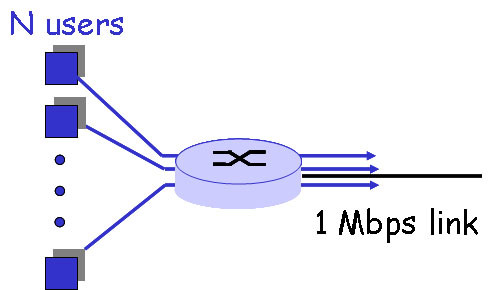

CDA6530: Performance Models of Computers and Networks
Fall 2011
Homework 1: Probability and Random Variables
(assigned 09/01; due: 09/08 midnight, submitted via Webcourse; late submisison deadline is 09/12 midnight with 20% off)
1. Bill and
George go target shooting together. Both shoot at a target at the same
time. Suppose Bill hits the target with prob. 0.7, George,
independently, hits the target with prob. 0.4.
a). Now both of them shoot once and exactly one shot hits the target.
What is the prob. that it was George's shot?
b). Now both of them shoot once and the target is hit. What is the
prob. that George hit it?
2. A
gamber has in his pocket a fair coin and a two-headed coin. He selects
one of the coins at a random, and when he flips it, it shows heads.
a). What is the probability tha it is a fair coin?
b). Suppose that he flips the same coin a second time and again it
shows heads. Now what is the probability that it is a fair coin?
3. An
airline knows that 5% of the people making reservations on a certain
flight will not show up. Consequently, their policy is to sell 52
tickets for a flight that can only hold 50 passengers. What is the
probability that there will be a seat available for every passenger who
show up?
4.
Consider three trails (they may not be independent), each of which is
either a success or not. Let X denote the number of successes. Suppose
E[X]=1.8
a). What is the largest possible value of P(X=3)?
b). What is the smallest possible value of P(X=3)?
5. Consider the
networks shown in the figure below. Assume computers in the
institutional network send out 13 requests per second to the "origin
servers" shown in the figure. Since each request is very small, we
assume there is no delay in sending out these requests and they take 1
second to arrive at the "orgin servers" and web response data take
another 1 second to come back at the Internet-side router on the
"access link". Each web response object average size is 100kbits.
Now congestion could happen at the access link when web response objects come back (we assume there is no delay in the institutional network LAN). Using M/M/1 queue to model the access delay in the 1.5Mbps access link. That is to say, the average response time (it is the time for a web response object arrives at the access link until it enters into institutional LAN) is E[T]=1/(m-n), where n is the arrival rate of objects to the access link and m is the service rate of the access link.

a). Find the total average response time when no institutional cache is used. The response time is the time from a browser sends out a request until it receives the web response object. (Hint: total delay includes Internet delay and access link delay)
b). Now suppose the institutional cache is used.
The hit rate for the cache is 0.6. Find
the total average response time.
6. The advantage of packet switching vs. circuit switching. The
following figure shows that many users are sharing a 1Mbps access link
to the Internet. Suppose each user is either in active status that
required data access rate of 100kbps, or in silence status that the
user requires no data. Each user is active only 10% of the time ,
and users are independent with each other in their activities.
